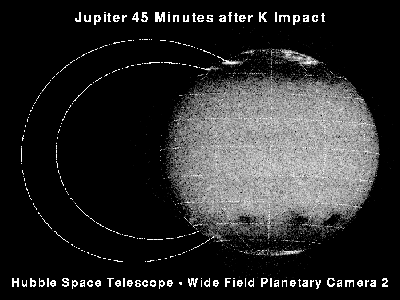

NOTE: Click on the image to view it at its highest resolution.
PHOTO RELEASE NO.: STScI-PRC94-45
FOR RELEASE: September 29,1994
This far-ultraviolet image of Jupiter taken with NASA's Hubble Space Telescope (HST) shows narrow auroral "arcs" that appeared at northern mid-latitudes following the impact of the K nucleus fragment of comet P/Shoemaker-Levy 9. (The dark K impact region is on the left limb, followed, from left to right, by the C, A, and E comet impact regions.)
The image was taken on 19 July 1994, 45 minutes after the K nucleus slammed into the gas giant planet. The image shows arc-like auroral emissions near the western (left) limb at mid-latitudes in the north, and fainter but remarkably similar emissions near the K impact site in the south.
The "arcs" are being produced by energetic charged particles, like the other auroral emissions, except that they appear to last less than one hour and they are at a location where Jupiter normally does not have aurora. They were apparently produced by the K impact, even though they appear bright in the northern hemisphere nearly 70,000 miles away from the impact site.
The overlay of magnetic field lines shows the path of the charged particles near Jupiter (from a model based on Pioneer and Voyager spacecraft data), starting at the northern "arcs" and tracing the magnetic field back to the impact site in the southern atmosphere. (There is an overlay of a longitude/latitude grid to indicate locations on Jupiter).
Aurorae, also known as the northern and southern lights, are produced by high energy charged particles, trapped in Jupiter's magnetic field, that cause atmosphereic gasses to glow.
Based on comparison with ROSAT satellite X-ray images of Jupiter also taken at time of the K impact, astronomers know that the northern disturbance was brightest near the time of the K impact, and then faded. If HST images had been taken during the K impact, they would likely have shown far brighter arcs than those observed 45 min. later.
The image was taken with the Wide Field Planetary Camera-2 at UV wavelengths (1300-2100 Angstroms), where the polar regions normally appear dark and the northern and southern lights are clearly visible.
Credit: John T. Clarke (U. of Michigan),
and NASA
![]() Images, Images, Images
Images, Images, Images
